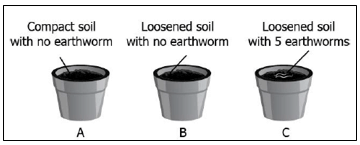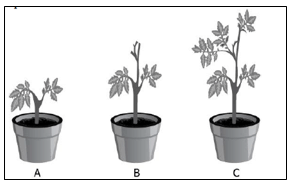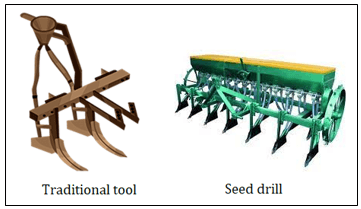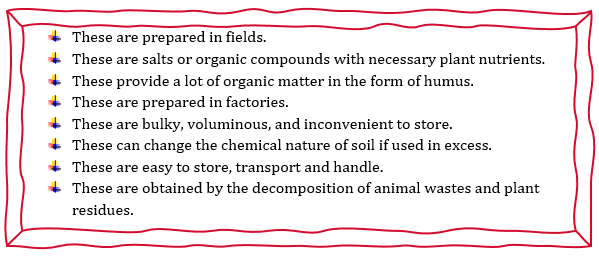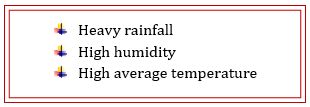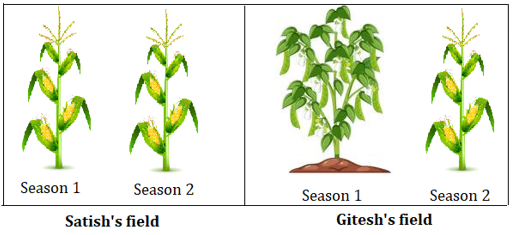Crop Production And Management Worksheet
Objective Type Questions
- Complete the chart by arranging the given agricultural practices in the correct sequence.
(Adding manure and fertilisers, Protection from weeds, Storage of grains, Sowing) - Match the terms in column A with appropriate terms in column B.
- Fill in the blanks by choosing the appropriate term from those given in the brackets.
(irrigation, animal husbandry, transplantation, ploughing, broadcasting)
(a) The process of loosening and turning the soil is called ……………………
(b) The sowing of seeds by hand is called ……………………
(c) The process of transferring the seedlings from a nursery to the main field by hand is called ……………………
(d) The process of supplying water to crop plants in the fields is called ……………………
(e) The branch of agriculture which deals with the feeding, shelter, health and breeding of domestic animals is called ……………………
Multiple Choice Questions - A group of students visited a field twice in the same year. They observed different crops on each trip as shown below.
Why did they observe different crops?
(a) Soyabean and groundnut are kharif crops which are sown in the rainy season while
mustard and pea are rabi crops which are sown in the winter season.
(b) Soyabean and groundnut are kharif crops which are sown in the winter season while
mustard and pea are rabi crops which are sown in the rainy season.
(c) Soyabean and groundnut are rabi crops which are sown in the rainy season while
mustard and pea are kharif crops which are sown in the winter season.
(d) Soyabean and groundnut are rabi crops which are sown in the winter season while
mustard and pea are kharif crops which are sown in the rainy season. - Supriya set up an experiment to study the growth of plants using three different types of soil as shown below.
She planted a bean seed in each of these pots and observed the growth of the plants for 2 months. Her observations are shown below.
What can Supriya conclude from this experiment?
(a) Earthworms increase the fertility of the soil.
(b) Compact soil increases the amount of nutrients in the soil.
(c) Earthworms restrict the growth of the plant by consuming it.
(d) Loosened soil with no earthworms allows maximum growth of the plant. - A farmer bought some maize seeds from the market. Before sowing the seeds, he placed the seeds in water and stirred the water. After few minutes, the farmer collected the seeds that settled down at the bottom and used them for sowing. What is the likely reason for choosing only these seeds for sowing?
(a) Seeds at the bottom are heavy which will result in plants with good growth.
(b) Seeds at the bottom are not damaged which will result in plants that are healthy.
(c) Seeds at the bottom are light which will result in plants that grow taller.
(d) Seeds at the bottom absorbed more water which will result in plants with high water absorption capacity. - If one wants to protect his seeds from being consumed by animals, which type of tool should he use for sowing the seeds?
(a) Seed drill as it coats a chemical over the seeds.
(b) Traditional tool attached to a plough as many seeds can be sown together.
(c) Seed drill as it covers the seeds with soil after sowing.
(d) Traditional tool attached to a plough as seeds pass through a funnel-shaped tube. - Ramesh wishes to restore the nutrients in the soil of his field without spending money on chemical fertilisers. Which natural method he should likely adopt for the replenishment of soil nutrients?
(a) Sowing seeds that are healthy
(b) Growing the same crops every year
(c) Growing different crops alternatively
(d) Supplying water to the crops at regular intervals - Kamlesh has a crop field in a small village of Rajasthan where there are no lakes, and the area receives very less rainfall. During summers, low availability of water limits the crop production. Which irrigation method should Kamlesh adopt to use water economically?
(a) Drip system
(b) Lever system
(c) Pulley system
(d) Sprinkler system - Hariya is a farmer who owns a large area of land. Every year he invests plenty of time for harvesting the crop manually using a sickle. Some farmers advised him to take the help of a machine called combine. How will this machine be useful to Hariya?
(a) The machine includes large sickles that decrease the harvesting time.
(b) The machine is a harvester as well as a thresher which saves time and energy.
(c) The machine is a harvester as well as a weed remover which reduces weeds in the field.
(d) The machine includes sowing process that sows new seeds to replace the harvested crop. - The chart lists some food items.
Which option correctly classifies the source of these food items?
Animal Source Plant Source (a) honey, eggs, fish oil, cheese, milk wheat, sunflower oil, beans, pulses, apple (b) honey, eggs, fish oil, sunflower oil, milk cheese, wheat, beans, pulses, apple (c) honey, eggs, fish oil, sunflower oil, apple milk, cheese, wheat, beans, pulses (d) sunflower oil, eggs, fish oil, cheese, milk wheat, honey, beans, pulses, apple
Subjective Questions - A farmer was turning the soil in the field constantly to loosen it. What is the likely reason for this agricultural practice?
- Kishan uses three different types of tools as shown below for tilling the soil in three different fields.
(a) Identify A, B and C.
(b) Kishan recorded the time taken to complete the tilling in each field using the above tools.
Which tool should be used by Kishan to till his fields effectively? - Observe the figures carefully and answer the questions based on them.
(a) Which agricultural practice is carried out using the above tools?
(b) What precautions should be taken while performing the given agricultural practice?
(c) Which of these tools saves time and labour? - The below chart lists some characteristics of manures and fertilisers. Categorise them as the characteristics of manures and fertilisers separately.
- A farmer observed that the growth of weeds in his field reduced the crop yield. What can the farmer do to prevent the growth of weeds without investing money on weedicides?
Case-Based Questions - India is a vast country wherein the climatic conditions like temperature, humidity and rainfall vary from one region to another. Accordingly, there is a rich variety of crops grown in different parts of the country.
a) What is the basis for dividing the cropping patterns as kharif and rabi crops?
(a) Flowering pattern
(b) Irrigation pattern
(c) Seasonal conditions
(d) Time taken to grow
b) The table lists the climatic conditions of an area. Which crop can be sown in such conditions?
(a) Gram
(b) Wheat
(c) Maize
(d) Mustard
c) Which of the following does not fit in the group?
(a) Maize, cotton, groundnut
(b) Wheat, gram, pea
(c) Mustard, linseed, gram
(d) Mustard, paddy, cotton - Satish grows maize plants in two consecutive seasons in his field. At the same time, Gitesh grows bean plant in one season and maize plant in the next season in his field 2 as shown below.
a) Whose field is likely to have soil with high nutrients for the growth of new plants in the third season?
(a) Satish’s field as cultivating same crops every season increases the productivity of the crops
(b) Gitesh’s field as cultivating different crops reduces the water requirement of crops
(c) Satish’s field as cultivating the same crops requires same type of nutrients
(d) Gitesh’s field as cultivating different crops restores the nutrients in the field
b) The method of crop production followed by Gitesh is called
c) Define this method.
Assertion-Reasoning Questions
Below questions consist of two statements – Assertion (A) and Reason (R). Answer these questions selecting the appropriate option given below: - Assertion (A): Chemical fertilisers should be used carefully and judiciously.
Reason (R): Excessive use of chemical fertilisers is harmful for the growth of plants. - Assertion (A): Crops cultivated in sandy soil need more frequent irrigation.
Reason (R): Sandy soil has poor water retaining capacity. - Assertion (A): Harvested grains must be properly dried in the sun to reduce the moisture in them.
Reason (R): Dried mint leaves are used for storing food grains at home.
Explore more Science Sample papers and Solutions
- Microorganisms: Friend And Foe Worksheet
- Coal And Petroleum Worksheet
- Combustion And Flame Worksheet
- Conservation Of Plants And Animals Worksheet
- Reproduction In Animals Worksheet
- Reaching the Age of Adolescence Worksheet
- Force And Pressure Worksheet
- Friction Worksheet
- Sound Worksheet
- Chemical Effects of Electric Current Worksheet
- Some Natural Phenomena Worksheet
- Light Worksheet
- Competency Based Questions for CBSE Class 8 Science
Key Features of CBSE Class 8 Science:
- Prepared by subject matter experts
- According to the latest CBSE syllabus
- Helpful when doing homework
- Easy to understand
- Helpful for quick revision
- Score more marks in the examination
- Free textbook solutions & doubt-solving sessions
- Increase paper-solving speed
- Improvement in marks




